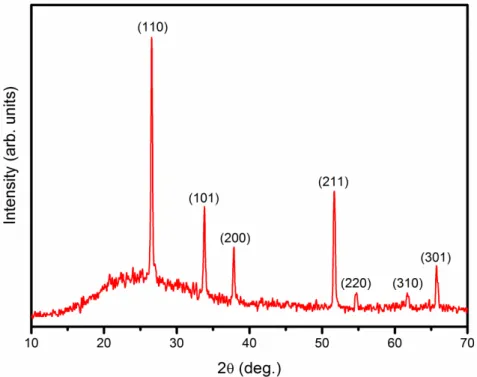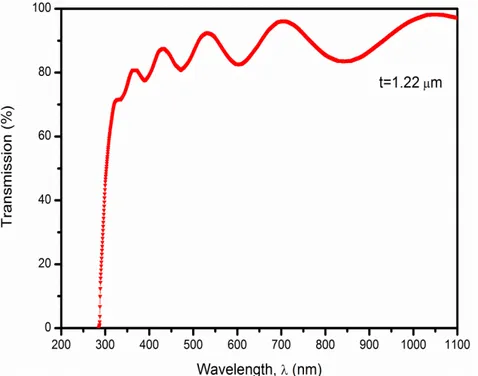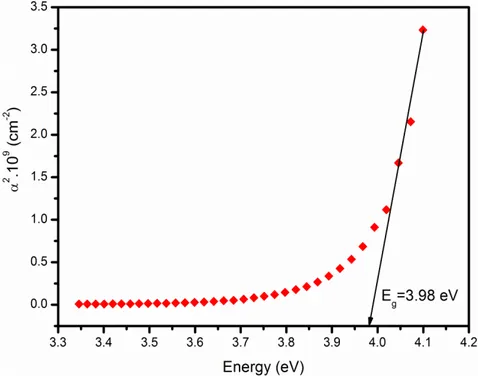* Corresponding Author
Received: 01 October 2018 Accepted: 30 December 2018
Determination of The Thickness and Optical Constants of Polycrystalline SnO2 Thin Film by Envelope Method
Özge ERKEN1,*, Cebrail GÜMÜŞ2
1Adıyaman University, Faculty of Arts and Sciences, Department of Physics, Adıyaman, Türkiye, ozgerken@adiyaman.edu.tr
2Çukurova University, Faculty of Arts and Sciences, Department of Physics, Adana, Türkiye, cgumus@cu.edu.tr
Abstract
SnO2 (tin dioxide) thin film was deposited on commercial glass substrate by spray pyrolysis technique at 420oC. The XRD analyses indicated that the SnO2 thin film is found to tetragonal rutile structure. Optical transmission values (T %) of the film are the range of 80-96 % in the visible region and its highly transparent. The absorption coefficients (α) were defined from transmission spectrum. Refractive indices (n) and film thickness (t) were determined from interferences of the optical transmission curve with envelope method. The refractive indices (n) were altered between 1.83-1.97 in the ultraviolet-visible-near-infrared (UV-VIS-NIR) regions. The thickness (t) and optical energy gap (Eg) of the SnO2 thin film were found to be 1.22 μm and 3.98 eV, respectively.
Keywords: SnO2 thin film, Spray pyrolysis technique, Envelope method, Optical constants.
Polikristal SnO2 İnce Filmin Kalınlık ve Optik Sabitlerinin
Zarf Yöntemi ile Belirlenmesi Özet
SnO2 (kalay dioksit) ince film ticari cam alttaban üzerinde 420oC’de püskürtme tekniği ile depolanmıştır. XRD analizleri SnO2 ince filmin tetragonal rutil yapıya sahip
dergipark.gov.tr/adyusci
olduğunu göstermiştir. Filmin optik geçirgenlik değerleri (% T) görünür bölgede % 80-96 aralığındadır ve son derece şeffaftır. Soğurma katsayıları (α) geçirgenlik spektrumundan hesaplanmıştır. Kırılma indisleri (n) ve film kalınlığı (t) zarf yöntemi kullanılarak optik geçirgenlik eğrisinin girişimlerinden belirlenmiştir. Ultraviyole-görünür-yakın kızılötesi (UV-VIS-NIR) bölgelerinde kırılma indisleri (n) 1.83-1.97 aralığında değişmiştir. SnO2 ince filmin kalınlığı (t) ve optik enerji aralığı, sırasıyla 1.22 μm ve 3.98 eV olarak bulunmuştur.
Anahtar Kelimeler: SnO2 ince film, Püskürtme tekniği, Zarf yöntemi, Optik sabitler.
1. Introduction
The dynamic improvement in wide band-gap metal oxide thin films and their common usage in the areas of technology have induced the increased interest to study them. Metal oxide thin films are the most common produced materials and these materials which are in a widespread manner used in optoelectronic devices such as photo-catalysts, gas sensors, photoelectron chemical devices, flat-panel displays and photovoltaic (PV) solar cells. Undoped and doped metal oxide thin films have a high optical transparency in the visible spectrum and conductivity near to that of metals. Among the available metal oxide thin films, pure and doped tin dioxide (SnO2) thin films on glass substrates are making used of commonly as window layers because of their transparency in the visible region of the spectrum in solar cells. Owing to their technological importance several researchers have investigated the improvement and characteristics of SnO2 films [1-4]. There is a comprehensive literature on tin dioxide films prepared on glass substrates by different techniques, e.g. aerosol assisted chemical vapor deposition (AA-CVD) method [5], sol-gel method [6], radio frequency magnetron sputtering (RFMS) [7], spin coating [8], electrodeposition technique [9] and spray pyrolysis technique [10]. Among them spray pyrolysis technique is one of the most commonly used technique obtainable of large area films owing to its low price and convenient for technological applications.
In this paper, we submit a study of the structural and optical properties of SnO2 thin film obtained by the spray pyrolysis technique on glass lower base. The aim of the study is the preparation of tin dioxide thin film as well as investigation of the usability of this film in solar cell. The structural properties of this film were identified by X-ray diffraction
(XRD). Also, optical properties of the film were inspected in the ultraviolet-visible-near infrared (UV-VIS-NIR) regions by means of spectrophotometer.
2. Experimental Procedure
SnO2 thin film was prepared glass lower base by spray pyrolysis technique. The glass lower base with dimensions of 76 mm x 26 mm x 1 mm was used for the deposition. Before deposition the glass lower base was cleaned with detergent, soaked in diluted chromic acid (H2CrO4), rinsed in deionized water, soaked for 3 min in isopropyl alcohol (C3H7OH), rinsed in deionized water and then dried in air prior to deposition. The properties of SnO2 thin film depend on various growth parameters such as substrate to nozzle distance, substrate cleaning, substrate temperature, time of deposition, the diameter of the nozzle, solution composition, and concentration. The spray solution, consisting of 7 ml of SnCl4, 400 ml of C3H7OH, 15 ml of HCl in H2O (30 ml), was sprayed on preheated chemically cleaned glass lower base. The solution was primed in pure water (Purelab flex 3, water purity: 18.2 MΩ at 25°C). The solution and carrying gas (air) are fed into the spray nozzle at pre-set fixed an atomization pressure. Subsequently, the nozzle-to-substrate distance was maintained at 30 cm, and thin film was deposited at 420°C. The flow speed of the solution was 10-12 ml/min. The diameter of the nozzle was 0.3 mm. The film formation is an oxidation process as shown below.
SnCl O → SnO 2Cl
The structural properties were characterized by Rigaku RadB XRD with CuK1 radiation with =1.5405 Å (30 kV, 15 mA, scanning speed=2/min). From the diffraction patterns, angle positions and relative intensities of Bragg reflections were determined. The optical properties of SnO2 thin film were investigated by a Perkin Elmer UV/VIS Lamda 2S spectrophotometer (λ =200-1100 nm) operating at room temperature. The absorption coefficient values (α) were defined from transmission spectrum. Refractive index values (n) and the thickness (t) of the film were determined from interferences of the optical transmission curve with envelope method. Refractive indices (n) were investigated for ultraviolet, visible and near-infrared (UV-VIS-NIR) regions. The optical energy gap (Eg) was determined from α 2-Energy graph.
3. Results and Discussion 3.1 Structural Properties
The structural properties of the SnO2 thin film were characterized by XRD measurements. The XRD pattern was obtained with 2θ from 10o to 70o.
Figure 1. The XRD pattern of SnO2 thin films deposited at 420°C.
The XRD pattern of the SnO2 thin film produced at 420oC substrate temperature is given in Figure 1. As a result of XRD pattern, it was determined that all the obtained peaks in Figure 1 were belonged to characteristic SnO2 phase. It was concluded that the SnO2 thin film was grown in polycrystalline structure and mainly in tetragonal phase. Apart from the strongest peak at 2θ=26.56o from diffraction pattern, many other peaks at 33.82o, 37.86o, 51.66o, 54.74o, 61.70o, 65.72o were also observed. (hkl) reflection planes corresponding to the peaks were (110), (101), (200), (211), (220), (310) and (301), respectively. It was observed that the preferred orientation was through the (110) plane. Also, lattice parameters, grain sizes (D), d-values, and full-width half maximum (FWHM) values for (110), (101), (200), (211) planes were calculated from the XRD data (see Table 1). The lattice parameters for tetragonal phase were determined from the relation:
1 d h k a l c
where a and c are lattice constants, (hkl) is Miller indices of the plane concerned and dhkl
is the interplanar spacing of the atomic planes.
Table 1. Structural parameters of SnO2 thin film
(hkl) Observed 2θ (deg.) Standard 2θ (deg.) Calculated d (Å) Standard d (Å) FWHM (deg.)
Grain Sizes (Å) Calculated Parameters a=b ; c (Å) Standart Parameters a=b ; c (Å) (110) 26.56 26.61 3.353 3.347 0.273 312.01 4.737 ; 3.179 4.738 ; 3.187 (101) 33.82 33.89 2.648 2.642 0.313 276.76 4.727 ; 3.183 4.738 ; 3.187 (200) 37.86 37.95 2.374 2.369 0.320 274.10 4.740 ; 3.178 4.738 ; 3.187 (211) 51.66 51.78 1.768 1.764 0.334 275.75 4.727 ; 3.187 4.738 ; 3.187
The calculated all values of SnO2 thin film are very well conformed with the standard values (Crystal system: tetragonal phase, space group: P42/mnm(135), a = 4.738 Å, c = 3.187 Å, PDF Card No: 041-1445). The grain sizes (D) were calculated using the Debye-Scherrer equation as below:
𝐷 0.94𝜆
𝐵 cos 𝜃
where, is the X-ray wavelength ( = 1.5405 Å), B is the observed angular width half maximum intensity (FWHM) of the peaks (radians) and B is Bragg diffraction angle [11].
3.2 Optical Properties
Figure 2 indicates the optical transmission curve of the SnO2 thin film between 200 and 1100 nm. The multiple peak points seemed in the transmission spectrum are emanate from optical interference. SnO2 thin film is highly transparent and its optical transmission values (T %) are 80-96 % in the visible region. Figure 2 clearly shows that a sharp-witted at about 285 nm. The optical transmission spectrums of the transparent films like SnO2 are dramatically influenced from grain sizes and morphological properties of the films [12].
Figure 2. The optical transmission curves of SnO2 thin film deposited at 420°C
The envelope method can typically used to determine the refractive indices (n) and the film thickness (t) if transmission spectrum is possessed optical interference [13]. The film thickness (t) was determined by utilizing the optical transmission curve of in Figure 2 by using the equation as below:
𝑡 𝜆 𝜆
2 𝑛 𝜆 𝜆 𝑛 𝜆 𝜆
in this equation n(λ1) and n(λ2) are the refractive index values at two contiguous minima (or maxima) at λ1 and λ2 wavelength. The thickness of the SnO2 thin film was found to be 1.22 μm. Refractive index values (n) are calculated as noted below:
𝑁 𝑁 𝑁 𝑛 ⁄
𝑁 𝑛 1
2 2𝑛
𝑇 𝑇
𝑇 𝑇
in these equations Tmax and Tmin are maximum and minimum transmittances at the same wavelength in a fitted envelope curve on the transmittance curve, also ns is the refractive
Figure 3. Variation of refractive index n versus wavelength of SnO2 thin film
The refractive indices (n) were calculated for wavelengths between 400-1100 nm for SnO2 thin film and the variations are shown in Figure 3. The refractive index values (n) were altered between 1.83-1.97 in the UV-VIS-NIR regions (in the range of 400-1100 nm). The refractive indices (n) were measured between 1.90-1.95 for the wavelengths from 550 to 700 nm which is consistent with the standard values in the literature [14, 15]. The absorption coefficients (α) of SnO2 thin film was defined from the optical transmission measurements and using the equation as below:
𝛼 1
𝑡ln 𝑇 𝑇
where t is film thickness, T is normalized transmittance. The variation of absorption coefficient (α) of SnO2 thin film with wavelength is shown in Figure 4.
Figure 4. Variation of absorption coefficient (α) versus wavelength of SnO2 thin film
The optical energy gap (Eg) was found for the allowed direct transition between the
conduction and valence bands from the Tauc Equation:
𝛼ℎ𝜈 A ℎ𝜈 𝐸 ⁄
in this equation α, hν and A are identified as absorption coefficient, photon energy and a constant, respectively. The optical energy gap Eg is estimated using determined cutting
point linearly at α2 = 0 in the energy spectrum. According to Figure 5, Eg value is found
Figure 5. α2 versus energy plot of SnO
2 thin film 4. Conclusions
Highly transparent polycrystalline SnO2 (tin dioxide) thin film was deposited on commercial microscope glass by spray pyrolysis technique at 420oC. Crystal structure of the SnO2 thin film is determined as tetragonal rutile structure by using XRD analyses. SnO2 thin film is highly transparent and its optical transmission values (T %) 80-96 % in the visible region. Refractive index values (n) and the thickness (t) of the film were determined from interferences of the optical transmission curve with envelope method. The thickness of the SnO2 thin film was found to be 1.22 μm. The refractive indices (n) were altered between 1.83-1.97 in the UV-VIS-NIR regions. The optical energy gap (Eg)
was found to be 3.98 eV. It can be said that the SnO2 thin film found applicable in solar cells due to its especially polycrystalline structure, refractive index values and high optical transmittance.
References
[1] Howari, H., Tomsah, I.B.I., Structural, optical and ellipsometric characteristics
of PVD synthesized SnO2 thin films on Pt coated silicon wafers, Optik, 144, 467-474,
[2] Al-Jawad, S.M.H., Influence of multilayer deposition on characteristics of
nanocrystalline SnO2 thin films produce by sol-gel technique for gas sensor application,
Optik, 146, 17-26, 2017.
[3] Deva Arun Kumar, K., Valanarasu, S., Kathalingam, A., Jeyadheepan, K.,
Nd3+ Doping effect on the optical and electrical properties of SnO2 thin films prepared by nebulizer spray pyrolysis for opto-electronic application, Mater. Res. Bull., 101,
264-271, 2018.
[4] Chen, Y., Meng, Q., Zhang, L., Han, C., Gao, H., Zhang, Y., Yan, H., SnO2 -based electron transporting layer materials for perovskite solar cells: A review of recent progress, J. Energy Chem., 35, 144-167, 2019.
[5] Abendroth, T., Schumm, B., Alajlan, S.A., Almogbel, A.M., Mäder, G., Härtel, P., Althues, H., Kaskel, S., Optical and thermal properties of transparent infrared
blocking antimony doped tin oxide thin films, Thin Solid Films, 624, 152-159, 2017.
[6] Ammari, A., Trari, M., Bellal, B., Zebbar, N., Effect of Sb doping on the
transport and electrochemical properties of partially amorphous SnO2 thin films, J.
Electroanal. Chem., 823, 638-646, 2018.
[7] Tao, H., Ma, Z., Yang, G., Wang, H., Long, H., Zhao, H., Qin, P., Fan, G.,
Room-temperature processed tin oxide thin film as effective hole blocking layer for planar perovskite solar cells, Appl. Surf. Sci., 434, 1336-1343, 2018.
[8] Zhang, X., Liu, X., Ning, H., Yuan, W., Deng, Y., Zhang, X., Wang, S., Wang, J., Yao, R., Peng, J., Characterization studies of the structure and properties of Zr-doped
SnO2 thin films by spin-coating technique, Superlattices Microstruct., 123, 330-337,
2018.
[9] Lajnef, M., Ezzaouia, H., Chtourou, R., Optical characterization of InAs film
grown on SnO2 substrate by the electrodeposition technique, J. Phys. D: Appl. Phys., 41,
[10] El Radaf, I.M., Hameed, T.A., El Komy, G.M, Dahy, T.M., Synthesis, structural, linear and nonlinear optical properties of chromium doped SnO2 thin films,
Ceram. Int., 45, 3072-3080, 2019.
[11] Gumus, C., Ulutas, C., Ufuktepe, Y., Optical and structural properties of
manganese sulfide thin films, Opt. Mater., 29, 1183-1187, 2007.
[12] Kim, T.W., Lee, D.U., Coho, D.C., Yoon, Y.S., Microstructural and optical properties of SnO2 thin films grown on heavily doped n-InP (100) substrates, Appl. Phys.
Lett., 79, 2187-2189, 2001.
[13] Swanepoel, R., Determination of the thickness and optical constants of
amorphous silicon, J. Phys. E: Sci. Instrum., 16, 1214-1222, 1983.
[14] Guneri, E., Gumus, C., Mansur, F., Kirmizigul, F., Studies on properties of
sprayed SnO2 thin films as a function of substrate-nozzle distance and substrate temperature, Optoelectron. Adv. Mat., 3, 383-389, 2009.
[15] Demiryont, H., Nietering, K., Surowiec, R., Brown, F.I., Platts, D.R., Optical
properties of spray-deposited tin oxide films, Appl. Opt., 18, 3803-3810, 1987.
[16] Abhirami, K.M., Matheswaran, P., Gokul, B., Sathyamoorthy, R., Asokan, K.,
Swift heavy ion provoked structural, optical and electrical properties in SnO2 thin films,





